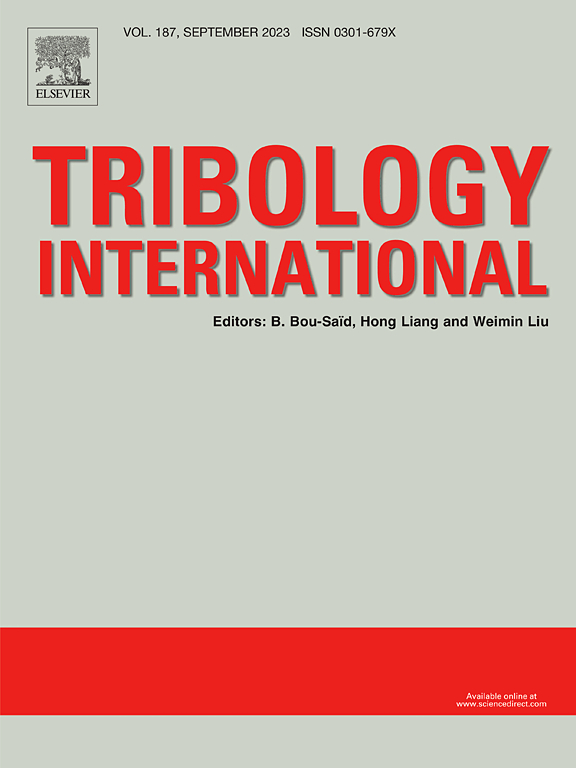Modeling adhesive contact behavior with interfacial displacement discontinuities
IF 6.1
1区 工程技术
Q1 ENGINEERING, MECHANICAL
引用次数: 0
Abstract
Coatings or layers are beneficial for modifying adhesive contact behaviors. However, imperfect bonding at the layer–substrate interface due to various factors can potentially affect adhesive contact responses. This study incorporates interfacial displacement discontinuity, accounting for dislocation-like and spring-like bonding imperfections, into an adhesive contact model. Adhesive interactions are modeled by Lennard-Jones(LJ) surface force law, with the effects of imperfections captured through layer surface deformation computed via fast Fourier transform (FFT). Therefore, a model for adhesive contact on an imperfect layer–substrate system is developed, and the effects of imperfection coefficients are then examined. The results indicate that normal imperfection coefficients have more pronounced effects than tangential ones, with smaller values exerting a greater impact. Dislocation-like imperfections dominate in contact systems with higher Tabor parameters, while spring-like imperfections are more prominent in systems with lower values. These imperfection coefficients, along with material parameters such as imperfection depth (layer thickness), the layer’s work of adhesion, and elastic modulus ratios, influence the adhesive force. The imperfection coefficients alter the adhesive force magnitude but do not affect the governing relationship between material parameters and adhesive force. Dislocation-like imperfections reduce adhesive force, while spring-like imperfections can either increase or decrease it, depending on the imperfection depth. Interfacial imperfections can raise the maximum subsurface von Mises stress, compromising system reliability. These findings emphasize the effects of discontinuous displacement-type imperfections on adhesive contact and provide valuable insights for engineering applications.
界面位移不连续的黏着接触行为建模
涂层或层有利于改变胶粘剂的接触行为。然而,由于各种因素,在层-基板界面上的不完美结合可能会影响粘合剂的接触响应。本研究将界面位移不连续(考虑到位错和弹簧粘合缺陷)纳入粘合剂接触模型。胶粘剂相互作用由Lennard-Jones(LJ)表面力定律建模,通过快速傅立叶变换(FFT)计算通过层表面变形捕获的缺陷的影响。因此,建立了不完善层-基体系的粘接接触模型,并对不完善系数的影响进行了研究。结果表明,正向缺陷系数比切向缺陷系数的影响更显著,且值越小影响越大。在Tabor参数较高的接触系统中,类位错缺陷占主导地位,而在Tabor参数较低的接触系统中,类弹簧缺陷更为突出。这些缺陷系数,连同材料参数,如缺陷深度(层厚度),层的粘合工作,弹性模量比,影响粘合剂。缺陷系数改变了胶粘力的大小,但不影响材料参数与胶粘力之间的调节关系。类位错缺陷会降低粘合力,而类弹簧缺陷则会增加或减少粘合力,这取决于缺陷的深度。界面缺陷会提高最大地下von Mises应力,从而影响系统的可靠性。这些发现强调了不连续位移型缺陷对粘接接触的影响,并为工程应用提供了有价值的见解。
本文章由计算机程序翻译,如有差异,请以英文原文为准。
求助全文
约1分钟内获得全文
求助全文
来源期刊

Tribology International
工程技术-工程:机械
CiteScore
10.10
自引率
16.10%
发文量
627
审稿时长
35 days
期刊介绍:
Tribology is the science of rubbing surfaces and contributes to every facet of our everyday life, from live cell friction to engine lubrication and seismology. As such tribology is truly multidisciplinary and this extraordinary breadth of scientific interest is reflected in the scope of Tribology International.
Tribology International seeks to publish original research papers of the highest scientific quality to provide an archival resource for scientists from all backgrounds. Written contributions are invited reporting experimental and modelling studies both in established areas of tribology and emerging fields. Scientific topics include the physics or chemistry of tribo-surfaces, bio-tribology, surface engineering and materials, contact mechanics, nano-tribology, lubricants and hydrodynamic lubrication.
 求助内容:
求助内容: 应助结果提醒方式:
应助结果提醒方式:


